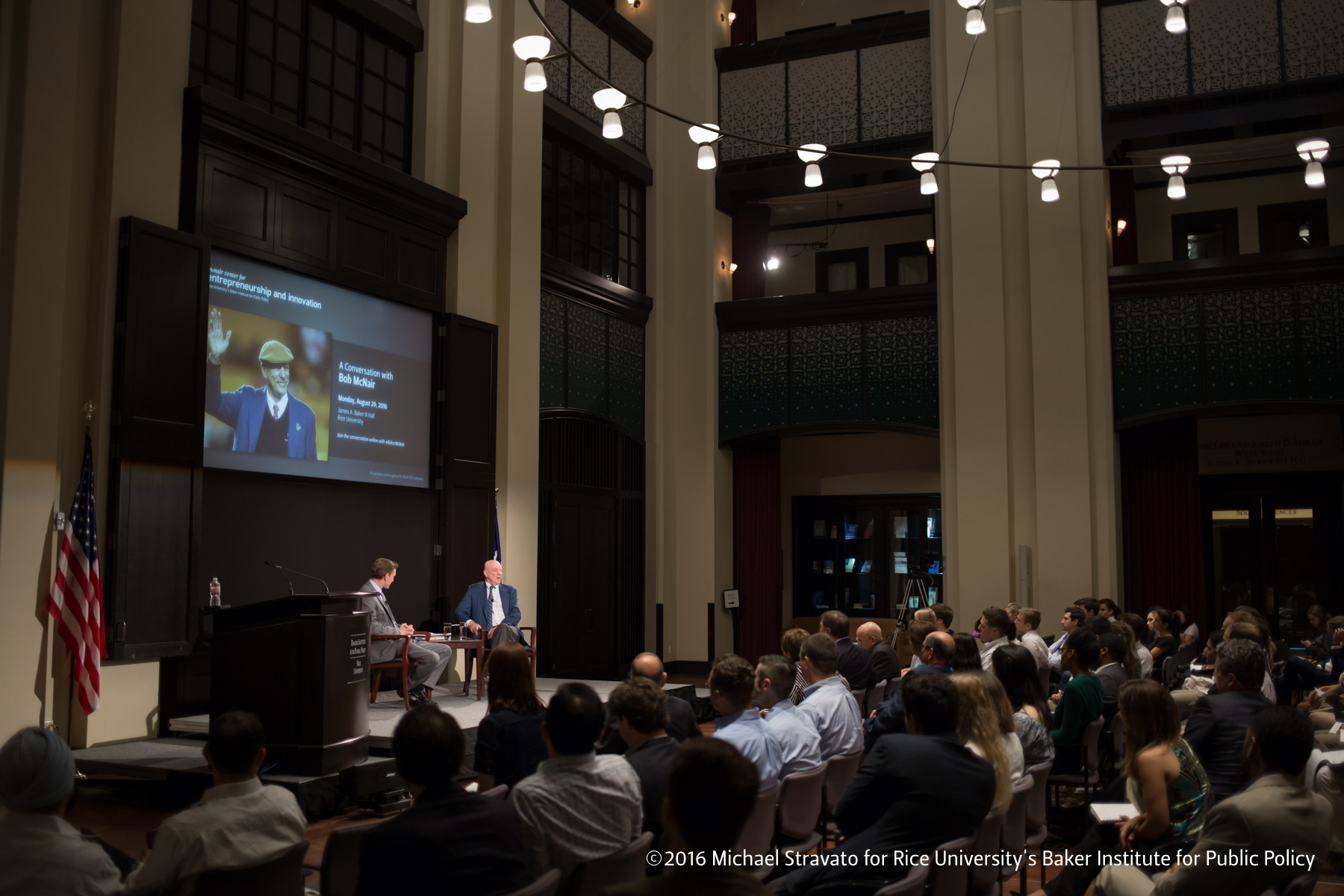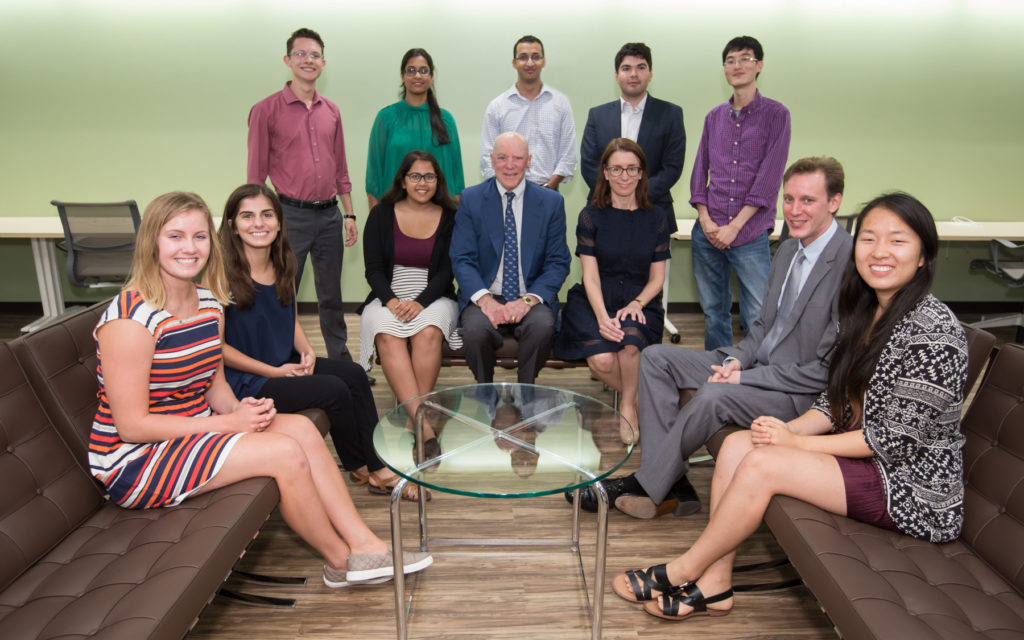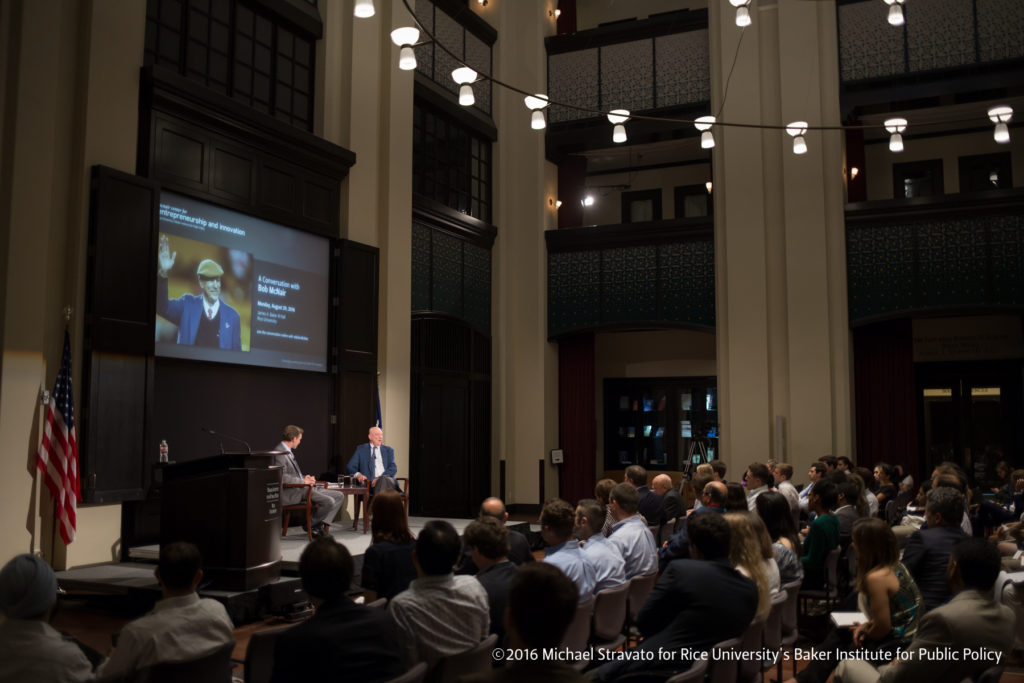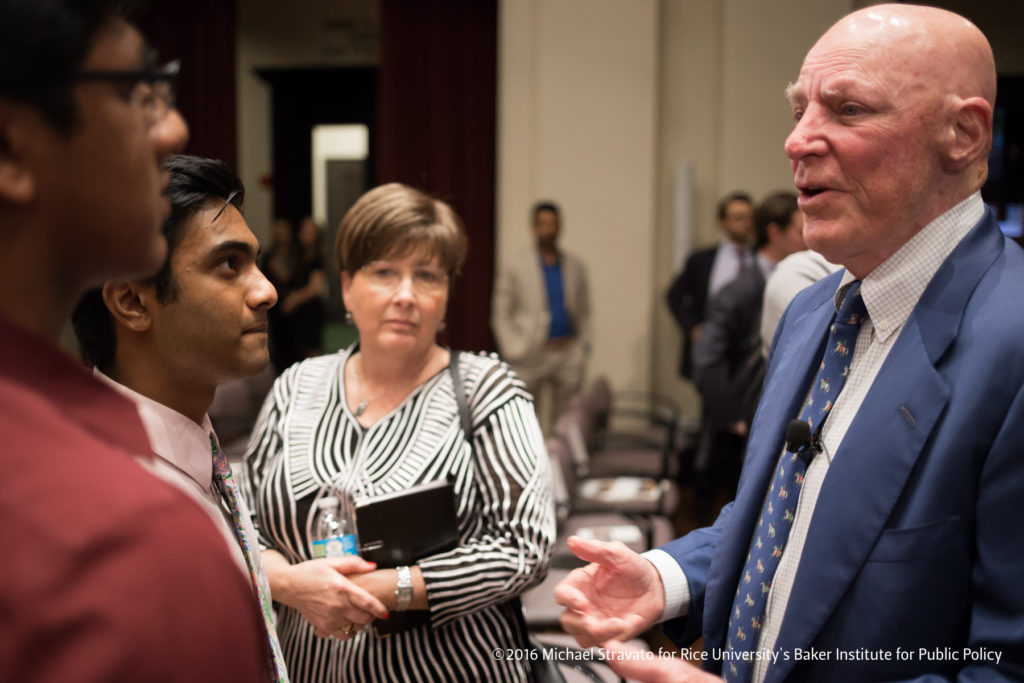Author: Julia Wang
Patents and the Cancer Moonshot: How Subject Matter Eligibility Affects Research
When standard cancer treatments fail, some doctors are turning to the developing field of immunotherapy. Immunotherapy involves treatments that use the patient’s own immune system to combat cancer. Both pharmaceutical companies and the federal government see the promise in funding research in this innovative field. However, R&D in cancer treatments is a time-intensive process, and it takes months, if not years, before doctors can bring cutting-edge research to their patients.
In January 2016, President Barack Obama called for the Cancer Moonshot to double the rate of progress in cancer research. Vice President Joe Biden traveled across the country and the world (including to Rice University) to collect information on current barriers in cancer research, like inefficiencies in the patent process. However, is the lengthy patent examination process truly what is slowing cancer research?
Accelerating the Process with “Patents 4 Patients”
To help accelerate cancer research, the United States Patent and Trademark Office launched the Cancer Immunotherapy Pilot Program (also known as “Patents 4 Patients”) in July 2016. This program aims to fast track the review of patents that involve treating cancer using immunotherapy.
Usually, the USPTO examines patents in order of their U.S. filing dates. However, under “Patents 4 Patients,” the Patent Office will grant special status to patent applications relating to cancer immunotherapy. The USPTO aims to finish examining petitions submitted before June 29, 2017 within twelve months of granting special status.
Often, USPTO examination takes a long time. Over the last two years, first office action pendency, or how long it takes to mail a First Office Action after a patent application is filed, takes an average of 16.5 months. Additionally, traditional total pendency, or how long it takes to decide whether to issue or abandon a patent, takes an average of 26.4 months. The new Pilot Program certainly has the potential to reduce these wait times. However, long patent examination periods are not the only barriers that researchers face when developing cancer treatments.
Patent Subject Matter Eligibility: A Look at Section 101
Under Section 101 of Title 35 of the United States Code, “any new and useful process, machine, manufacture, or composition of matter, or any new and useful improvement” is patent-eligible. Over the past few years, the U.S. Supreme Court has affected what is patentable. Under judicially recognized exceptions, laws of nature, natural phenomena and abstract ideas cannot be patented.
Most controversially, in Mayo v. Prometheus (2012), the Court held that correlations between blood test results and patient health were “laws of nature” and that any claims relating to these correlations were patent ineligible under 35 U.S.C. §101. Similarly, in AMP v. Myriad (2013), the Supreme Court held that claims relating to isolations of naturally occurring DNA cannot be patented.
Because of these decisions, the USPTO has rejected or abandoned many patents relating to cancer immunotherapy treatment on the basis that they claim laws of nature. According to Patently-O, patent rejections based on Section 101 objections increased substantially after the Mayo ruling from 15.9% of office actions to 86.1%.
For example, the USPTO has rejected patents relating to using gene expressions to predict chances of breast cancer (US20100035240A1) and using a specific protein as an early indicator of cancer (US20150072355A1) because they are applications of laws of nature. However, unlike the USPTO, the patent offices in Europe, Japan, and China have accepted these applications and granted their patents. Current U.S. patent law does not conform with internationally recognized forms of patent eligibility. Stifling the progress of research through patent rejections does not bode well for U.S. cancer patients. By refusing to protect emerging discoveries, the USPTO undermines cancer treatment research, especially in innovative fields like immunotherapy.
More Barriers with the FDA Approval Process
Even after a treatment is patented, it can take years to go through the phases of the clinical trial process. Phase I and II determine the safety and promise of a treatment. Phase III tests the effectiveness of the new treatment compared to existing standards. After successfully going through trials, companies file a New Drug Application (NDA) for Food and Drug Administration (FDA) approval.
According to DiMasi, Grabowski and Hansen (2016), clinical trials take an average of 9 years and 8 months. After a company submits an NDA, the FDA takes an average of 16 months to review it. This lengthy approval process further slows down R&D in cancer treatment.
Improving Subject Matter Eligibility Guidelines
Excludability in fast-growing fields like immunotherapy is extremely valuable in the early stages of R&D. Patents provide stability and a relative level of certainty, so a more quickly granted patent can help firms stake their claim in a developing treatment. However, the higher amount of claims rejections decreases the probability that companies will be able to protect their research. Questions about what is patent-eligible material could discourage investment and deprive researchers of necessary funding.
The Cancer Moonshot initiative is eager to make the patent process more efficient to quicken the progress of cancer treatment. While Patents 4 Patients could potentially help expedite research, long pendency periods are not the only barrier to accelerating research. Many discoveries are patentable, nonobvious applications of laws of nature. Yet, after recent court rulings, the USPTO still rejects their patent applications.
In late 2016, the USPTO held two roundtables to improve the its guidance for patent examiners on subject-matter eligibility. As judges and policymakers continue to define what can be patented, they must recognize the impact of their decisions on cancer treatment innovation.
An Outlet for Owlets: New Opportunities for Entrepreneurship and Innovation at Rice
On November 15, the Princeton Review ranked Rice University’s Jones Graduate School of Business third in the top graduate programs for entrepreneurship. For the past eight years, the Jones School’s entrepreneurship program has ranked in the top 10 in the nation. In addition to the Jones School’s ongoing success, several programs focus on undergraduate entrepreneurship and innovation. Recently launched programs promote entrepreneurship through student-led efforts and university-sponsored initiatives.
Consolidating student-led efforts
At the end of Spring 2016, two undergraduate entrepreneurship clubs, Rice Launch (led by Ben Herndon-Miller and Jake Nyquist) and Rice Conversations (led by Iris Huang and Doria Du), merged to form the Rice Entrepreneurship Club. The new club organizes a variety of events, including casual lunch conversations with entrepreneurs, pitch practices and mentor workshops.
Working closely with the Rice Alliance for Technology and Entrepreneurship and the Rice Entrepreneurship Initiative, the club shares opportunities and resources to encourage greater student collaboration. “I think the merge empowered the student leaders from both clubs to better serve student entrepreneurs at Rice,” said Iris Huang ’17, President of the Entrepreneurship Club. “With the substantial pool of combined resources, we are now able to put on more diverse programs and make a larger impact on the student population.”
Developing university-wide programs
In March 2016, Rice alumnus Frank Liu and his family gave $16.5 million to establish the Liu Idea Lab for Innovation and Entrepreneurship (Lilie). Headed by Dr. Yael Hochberg and Dr. Abby Larson, Lilie gives students access to the expertise and experiences that will help them launch their own enterprises. Beginning next spring, courses offered through Lilie will encourage students to solve real-world problems while working with faculty and entrepreneurs. The Lilie New Entrepreneurs Grant will help incoming freshmen, starting with the Class of 2020, to fund their business ventures. Before matriculating, freshmen can apply for the $10,000 grant that funds the most creative and compelling business ideas.
Learning from entrepreneurs

Through casual conversations and more formal lectures, the Entrepreneurship Club and Lilie have emphasized directly connecting students with entrepreneurs.
On September 15, the club hosted NeoSensory, a startup co-founded by Scott Novich (Rice PhD ‘16). NeoSensory mathematically maps data streams with temporal characteristics to develop a vest that helps the deaf experience sound through touch. More than 70 attendees learned about the product development timeline, the investment process and university intellectual property licensing through the perspective of a startup.
More recently, on October 19, the Rice Entrepreneurship Club hosted a conversation with Shaan Puri from Monkey Inferno, a San Francisco incubator that turns Internet project ideas into successful businesses. Monkey Inferno sold Bebo to AOL for $850 million in 2008 and currently uses that money to fund new projects. Puri shared his perspectives on forming teams and overcoming conflict and disappointment. Additionally, he advised students to become “learning machines,” always looking to learn more and improve. To achieve momentum, Puri encouraged aspiring entrepreneurs to dedicate time each day to their business idea.

As part of the Lilie Lecture Series, Dr. Larson hosted an event with Samantha Snabes on October 26. Snabes served as the Entrepreneur-in-Residence and Strategist at NASA and founded re:3D, which makes 3D printing more accessible and scalable. During the lecture, Snabes spoke about taking big risks and establishing strong relationships with peers and mentors. When asked about the differences between the startup cultures of the Silicon Valley and cities in Texas, Snabes noted the benefits of being located in Texas while Austin, Dallas and Houston are growing as centers of startup activity.
Dr. Larson explains, “The Lectures bring together expertise and energies from across Rice and Houston. Each Lecture features the insights of an established entrepreneur or innovator on a question of interest to people working across a range of fields. The Lectures provide an opportunity for the exchange of questions and ideas between people who are innovating in many different contexts, and as such, often lead to new and shared insights.”
Engaging undergraduates in entrepreneurial activity
November 4-6, Rice and University of Houston students used this advice to develop technology ventures at 3 Day Startup. During the event, 45 students worked together in 9 teams at TMCx. Prototypes included an Airbnb-style app that connects travelers with locals for authentic meal experiences, a frictionless rental service for household tools and a marketplace where artists can cater to consumers’ requests for original artwork.
Maintaining momentum
The increased focus on entrepreneurship and innovation on campus is promising. This spark will attract more entrepreneurial talent and advance Rice University’s reputation as a hub for innovation.
Generating an Innovation Nation
The Obama administration’s policies toward small business and entrepreneurship have received mixed reactions. While Obama elevated the administrator of the Small Business Administration to a cabinet position and the SBA increased its lending to small businesses, some small business owners felt that the government bailed out big businesses at their expense after the 2008 financial crisis. Many small business owners are concerned about the effects of the Affordable Care Act.
Over the course of his presidency, Obama has played a part in connecting innovation with government. During his first term, he created the positions of Chief Technology Officer, Chief Data Scientist and Chief Performance Officer. In 2012, he began selecting entrepreneurs to work as Presidential Innovation Fellows within the federal government to make government more efficient, impactful and user-friendly.
Inspired by startups and music
Austin’s South by Southwest music and media festival inspired President Obama’s latest innovation project South by South Lawn (SXSL). Last month, the Obama administration invited community change-makers nominated by the public to attend SXSL. Innovators gathered at the White House to discuss how they use technology to advance areas like technology, food, art and collaboration.
On the technology panel “Fixing Real Problems,” innovators like Chris Redlitz (founding partner of Transmedia Capital and founder of The Last Mile), Jukay Hsu (founder of Coalition for Queens) and Nina Tandon (founder of EpiBone) addressed societal issues, including criminal justice reform, health care costs, access to higher education and job opportunities. Panelists emphasized the importance of understanding the impact of company growth on surrounding communities when planning for future endeavors. They emphasized the importance of creating inclusive access to the new opportunities brought about by societal transformation and technological change.
Focus on social entrepreneurship
With the Access Code program at Coalition for Queens, Jukay Hsu aims to increase economic opportunities in Queens. The program allows populations usually underrepresented in the technology field, like women and minorities, to gain the skills needed to enter the field. There are no upfront costs, but graduates of the program are expected to “pay it forward” by committing a percentage of their first two year’s salary toward funding future Access Code cohorts.
Chris Redlitz created The Last Mile in 2008 in an effort to reduce recidivism rates. For successful criminal justice reform, inmates need the skills to readjust to the outside world. To meet this need, the Last Mile started a six-month program for inmates to develop companies and pitch their ideas to the business community. In 2014, Redlitz created the first computer coding program in a United States prison, teaching HTML, JavaScript, CSS and Python.
Nod to for-profit entrepreneurship
At EpiBone, Nina Tandon provides patient-specific, customized bone grafts created from the patient’s own stem cells. Through this personalization of treatment, she aims to simplify procedures, provide more exact care and reduce the costs of post-surgery treatments. Each year, over 100,000 patients have bone-related surgeries in the United States alone. EpiBone could potentially increase access to these necessary operations through reducing costs and rehabilitation times.
Bringing innovation within government
Obama invited technology executives to join him in Washington to spearhead innovation in government. Former Google executive Megan Smith now serves as the United States Chief Technology Officer. Microsoft executive Kurt DelBene took a leave of absence in 2013 to help fix the problems with HealthCare.gov.
At SXSL, Presidential Innovation Fellows shared their projects to improve government efficiency at the “Startup in the White House” exhibit. Jacqueline Kazil’s GeoQ crowdsources geo-tagged photos to quicken disaster response. With the Green Button Initiative, John Teeter aims to help Americans understand and improve their energy use. The innovation company 18F has been developing NotAlone.Gov to provide students and schools with access to resources against sexual assault. Visitors saw how design and technology could potentially modernize the immigration system, improve veterans’ access to benefits and increase cancer patients’ access to clinical trials.
The first SXSL – and the last?
Although technology will not cure all of society’s ills, it has the potential to improve lives more quickly than any government institution could. Continuing initiatives that focus on creative solutions leads to a more widespread awareness of this potential. The federal government should focus on technology and innovation as integral contributors of growth.
Obama used SXSL to show innovation’s potential in policy solutions. Unfortunately, he made no mention of policy toward small businesses, particularly for-profit enterprises. Events like SXSL must also focus on policy that accelerates for-profit entrepreneurship that aid U.S. economy growth. There was no mention of how the federal government would incentivize entrepreneurship to strengthen the U.S. economy and maintain competitiveness in the global marketplace.
Whether through another South by South Lawn or the inclusion of innovators in policy solutions, the Trump administration should seek to make government more inclusive, transparent and effective. However, simply embracing startup culture and bringing entrepreneurs into government is far from enough. For entrepreneurship to play its full role, the U.S. needs policies that will actually help small businesses, not hinder. Only then will small enterprises and startups be able to take their place as drivers of economic growth.
A Conversation with Bob McNair
On August 29, 2016, the McNair Center for Entrepreneurship and Innovation hosted an evening with Bob McNair. As the founder of Cogen Technologies and the founder, chairman, and CEO of the Houston Texans, McNair drew on his vast experience in business and philanthropy to offer advice to Rice University students and young professionals.
In 1960, McNair arrived in Houston with $700 and a goal to break into the trucking industry. However, after he established his trucking company, the industry became deregulated, forcing him into millions of dollars of debt. Despite this failure, McNair used his new knowledge of deregulation to find opportunity in three industries: intermodal transport, telecommunications, and cogeneration. Cogeneration, or the concurrent production of electricity and heat, became McNair’s most successful investment, and in 1999, he sold his company Cogen Technologies for $1.5 billion.
When asked for career advice, McNair emphasized to students and young professionals the importance of adding value to their environments. “The most important thing is putting yourself in a position where you can add the most value, and when you add the most value, the compensation will come to you,” he stated.
This idea of adding value was behind the $8 million endowment from the Robert and Janice McNair Foundation that launched the McNair Center for Entrepreneurship and Innovation at Rice University, one of six across the country. McNair said, “this is an opportunity for us to make a real contribution to society and to help create an environment that empowers ingenuity and creativity, unleashes the productivity of private enterprise and builds sustainable economic growth.”
Read more in the Baker Institute’s newsletter and the Rice Thresher’s article on the event.








